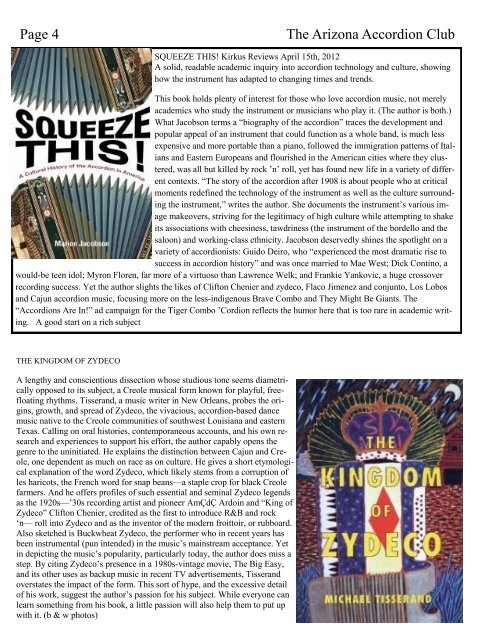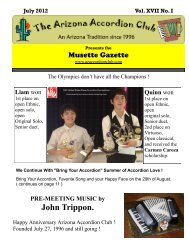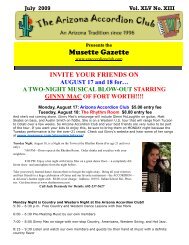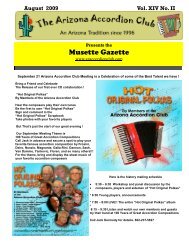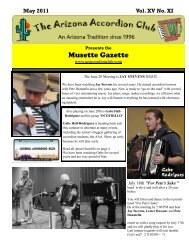May 2012 - Arizona Accordion Club
May 2012 - Arizona Accordion Club
May 2012 - Arizona Accordion Club
You also want an ePaper? Increase the reach of your titles
YUMPU automatically turns print PDFs into web optimized ePapers that Google loves.
Page 4<br />
The <strong>Arizona</strong> <strong>Accordion</strong> <strong>Club</strong><br />
SQUEEZE THIS! Kirkus Reviews April 15th, <strong>2012</strong><br />
A solid, readable academic inquiry into accordion technology and culture, showing<br />
how the instrument has adapted to changing times and trends.<br />
This book holds plenty of interest for those who love accordion music, not merely<br />
academics who study the instrument or musicians who play it. (The author is both.)<br />
What Jacobson terms a “biography of the accordion” traces the development and<br />
popular appeal of an instrument that could function as a whole band, is much less<br />
expensive and more portable than a piano, followed the immigration patterns of Italians<br />
and Eastern Europeans and flourished in the American cities where they clustered,<br />
was all but killed by rock ’n’ roll, yet has found new life in a variety of different<br />
contexts. “The story of the accordion after 1908 is about people who at critical<br />
moments redefined the technology of the instrument as well as the culture surrounding<br />
the instrument,” writes the author. She documents the instrument’s various image<br />
makeovers, striving for the legitimacy of high culture while attempting to shake<br />
its associations with cheesiness, tawdriness (the instrument of the bordello and the<br />
saloon) and working-class ethnicity. Jacobson deservedly shines the spotlight on a<br />
variety of accordionists: Guido Deiro, who “experienced the most dramatic rise to<br />
success in accordion history” and was once married to Mae West; Dick Contino, a<br />
would-be teen idol; Myron Floren, far more of a virtuoso than Lawrence Welk; and Frankie Yankovic, a huge crossover<br />
recording success. Yet the author slights the likes of Clifton Chenier and zydeco, Flaco Jimenez and conjunto, Los Lobos<br />
and Cajun accordion music, focusing more on the less-indigenous Brave Combo and They Might Be Giants. The<br />
“<strong>Accordion</strong>s Are In!” ad campaign for the Tiger Combo ’Cordion reflects the humor here that is too rare in academic writing.<br />
A good start on a rich subject<br />
THE KINGDOM OF ZYDECO<br />
A lengthy and conscientious dissection whose studious tone seems diametrically<br />
opposed to its subject, a Creole musical form known for playful, freefloating<br />
rhythms. Tisserand, a music writer in New Orleans, probes the origins,<br />
growth, and spread of Zydeco, the vivacious, accordion-based dance<br />
music native to the Creole communities of southwest Louisiana and eastern<br />
Texas. Calling on oral histories, contemporaneous accounts, and his own research<br />
and experiences to support his effort, the author capably opens the<br />
genre to the uninitiated. He explains the distinction between Cajun and Creole,<br />
one dependent as much on race as on culture. He gives a short etymological<br />
explanation of the word Zydeco, which likely stems from a corruption of<br />
les haricots, the French word for snap beans—a staple crop for black Creole<br />
farmers. And he offers profiles of such essential and seminal Zydeco legends<br />
as the 1920s—’30s recording artist and pioneer AmÇdÇ Ardoin and “King of<br />
Zydeco” Clifton Chenier, credited as the first to introduce R&B and rock<br />
‘n— roll into Zydeco and as the inventor of the modern froittoir, or rubboard.<br />
Also sketched is Buckwheat Zydeco, the performer who in recent years has<br />
been instrumental (pun intended) in the music’s mainstream acceptance. Yet<br />
in depicting the music’s popularity, particularly today, the author does miss a<br />
step. By citing Zydeco’s presence in a 1980s-vintage movie, The Big Easy,<br />
and its other uses as backup music in recent TV advertisements, Tisserand<br />
overstates the impact of the form. This sort of hype, and the excessive detail<br />
of his work, suggest the author’s passion for his subject. While everyone can<br />
learn something from his book, a little passion will also help them to put up<br />
with it. (b & w photos)


